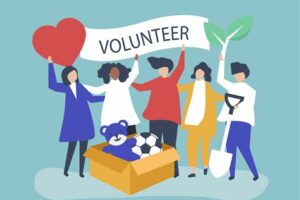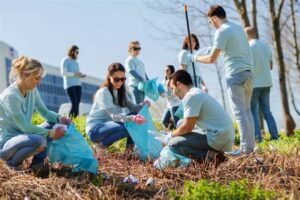Table of Contents
Engage in rewarding restoration volunteer work and make a positive impact on the environment. Join hands with dedicated volunteers to conserve ecosystems, restore habitats, and protect endangered species. Contribute your skills and passion towards creating a sustainable future for our planet through hands-on restoration projects. Sign up now and be part of a transformative experience.
Restoration volunteer work offers a unique opportunity to make a lasting impact on the environment while gaining valuable skills and experiences. Whether you have a passion for conservation or simply want to contribute to a greater cause, participating in restoration projects can be a fulfilling and rewarding endeavor. With a variety of tasks ranging from planting trees and removing invasive species to restoring natural habitats, there is always something for everyone to get involved in. Moreover, not only does restoration volunteer work allow you to connect with like-minded individuals, but it also provides a chance to learn from professionals in the field and expand your network of contacts. By dedicating your time and effort to this noble cause, you can play a crucial role in preserving our planet’s natural beauty for future generations.
The Importance of Restoration Volunteer Work
In today’s world, where environmental degradation and habitat loss are becoming increasingly prevalent, restoration volunteer work plays a crucial role in preserving our planet’s natural resources. Restoration work involves repairing or renewing damaged ecosystems, such as forests, wetlands, and rivers, to restore their ecological balance and enhance biodiversity. This article explores the significance of restoration volunteer work and how individuals can contribute to this noble cause.
1. Protecting and Enhancing Biodiversity
One of the primary objectives of restoration volunteer work is to protect and enhance biodiversity. Many ecosystems around the world are experiencing the loss of plant and animal species due to human activities. By engaging in restoration efforts, volunteers can help create suitable habitats for endangered plants and animals, allowing them to thrive and contribute to a more balanced and diverse environment.
2. Mitigating Climate Change
Restoration volunteer work also plays a vital role in mitigating climate change. Healthy ecosystems act as carbon sinks, absorbing and storing carbon dioxide from the atmosphere. By restoring degraded ecosystems, volunteers can help combat climate change by reducing greenhouse gas emissions and promoting sustainable carbon sequestration.
3. Improving Water Quality
Restoration efforts often focus on improving water quality in rivers, lakes, and wetlands. Volunteers participate in activities such as cleaning up polluted water bodies, removing invasive species, and planting native vegetation to filter out pollutants and restore natural hydrological processes. These actions contribute to cleaner water sources, benefiting both wildlife and human communities.
4. Preventing Soil Erosion
Soil erosion is a significant environmental issue that affects agricultural productivity, water quality, and overall ecosystem health. Restoration volunteer work involves implementing erosion control measures such as reforestation, constructing terraces, and establishing cover crops. These measures help prevent soil erosion, maintain fertile soils, and protect vulnerable landscapes from degradation.
5. Engaging Communities
Restoration volunteer work provides an excellent opportunity to engage local communities in environmental conservation. By participating in restoration projects, community members develop a deeper connection with their natural surroundings, fostering a sense of pride and ownership over their environment. This engagement can lead to long-term sustainable practices and promote a culture of environmental stewardship.
6. Learning and Skill Development
Volunteering in restoration projects offers valuable learning experiences and skill development opportunities. Participants gain practical knowledge about ecological processes, species identification, and restoration techniques. They also develop teamwork, leadership, and problem-solving skills, which can be transferable to various aspects of life and future careers.
7. Strengthening Conservation Efforts
Restoration volunteer work complements the larger conservation efforts undertaken by governments, NGOs, and scientific institutions. Volunteers provide additional manpower and resources to support ongoing restoration projects, making them more effective and scalable. Their contributions help accelerate the restoration process, ensuring the preservation of critical ecosystems for future generations.
8. Creating Lasting Impact
Engaging in restoration volunteer work allows individuals to create a lasting impact on the environment. By dedicating their time and effort, volunteers contribute to the long-term sustainability and resilience of ecosystems. Even small-scale restoration projects can have significant ripple effects, positively influencing the surrounding environment and inspiring others to take action.
9. Building Connections and Networks
Volunteering in restoration projects brings people together who share a common passion for the environment. It provides opportunities to connect with like-minded individuals, form friendships, and build professional networks within the conservation field. These connections can lead to future collaborations and collective efforts towards protecting our planet.
10. Inspiring Others
Lastly, restoration volunteer work serves as an inspiration for others to get involved in environmental conservation. When individuals witness the positive changes brought about by restoration efforts, they are more likely to recognize their own capacity to make a difference. By leading by example, restoration volunteers inspire others to take action and become stewards of the environment.
Introduction to Restoration Volunteer Work
Restoration volunteer work involves participating in community-driven efforts to restore and conserve natural habitats, historical sites, cultural artifacts, or infrastructure. It is a noble form of community service that allows individuals to contribute their time and skills towards preserving and enhancing the beauty and significance of various areas.
Impact on Natural Habitat Restoration
By engaging in restoration volunteer work, individuals play a crucial role in the revitalization of natural habitats. This may involve activities such as planting native trees and vegetation, removing invasive species, restoring wetlands, or creating wildlife-friendly environments. These efforts help to mitigate the negative impacts of human activities, promote biodiversity, and restore the ecological balance of ecosystems.
Preservation of Historical Sites
Restoration volunteer work often includes projects aimed at preserving and restoring historical sites. Volunteers may assist in restoring old buildings, maintaining architectural elements, cleaning and repairing sculptures or murals, or cataloging historical artifacts. By contributing their time and expertise, volunteers ensure that these tangible links to the past are preserved for future generations to appreciate and learn from.
Cultural Artifact Conservation
Volunteer work focused on cultural artifact conservation aims to safeguard important cultural treasures for the benefit of society. This can involve assisting museums or archives in cataloging, cleaning, or restoring valuable artworks, manuscripts, photographs, or artifacts. Through their dedication and meticulous efforts, volunteers play a vital role in ensuring the longevity and accessibility of cultural heritage.
Infrastructure Restoration
Restoration volunteer work may also involve efforts to restore and maintain infrastructure in communities affected by natural disasters or neglect. Volunteers may assist in rebuilding homes, repairing roads and bridges, restoring public spaces, or constructing sustainable systems. By lending their skills and labor, these volunteers help communities recover, thrive, and become more resilient.
Skills Development and Networking Opportunities
Engaging in restoration volunteer work provides individuals with invaluable opportunities for skills development and networking. Volunteers can gain hands-on experience in various fields such as carpentry, masonry, gardening, archival methods, or project management. Additionally, they can connect with like-minded individuals and professionals, potentially leading to new friendships, mentorships, or career opportunities.
Environmental Education and Awareness
Many restoration volunteer programs focus on raising environmental awareness and educating both volunteers and the wider community. Through workshops, guided tours, or informative sessions, volunteers learn about the importance of ecological balance, environmental sustainability, and historical preservation. By sharing this knowledge, volunteers become ambassadors for change in their communities.
Personal Satisfaction and Community Impact
Engaging in restoration volunteer work yields immense personal satisfaction as it allows individuals to make a positive impact on their communities. By actively participating in projects that restore and preserve nature, history, or cultural heritage, volunteers contribute to the betterment of societies. Witnessing the tangible results of their efforts and knowing that they have helped protect and enhance the world around them is truly rewarding.
Restoration volunteer work is an invaluable endeavor that provides individuals with a unique opportunity to contribute to the preservation and enhancement of natural or cultural heritage sites. Through their dedicated efforts, volunteers play a crucial role in restoring and maintaining these sites, ensuring their longevity for future generations to appreciate and enjoy. The significance of restoration volunteer work cannot be overstated, as it not only helps protect our planet’s natural and historical treasures but also fosters personal growth and a deeper connection to the environment.
Here are some key points highlighting the importance of restoration volunteer work:
- Preservation of natural and cultural heritage: Restoration volunteer work allows individuals to actively participate in the preservation of natural habitats, ecosystems, and culturally significant sites. By volunteering their time and skills, individuals contribute to the conservation of these invaluable resources, helping to protect them from degradation or destruction.
- Hands-on learning experience: Engaging in restoration volunteer work provides individuals with a hands-on learning experience that goes beyond what can be gained through textbooks or classroom settings. Volunteers have the opportunity to learn about ecological systems, historical contexts, and conservation techniques directly from experts in the field. This experiential learning promotes a deeper understanding and appreciation of the environment and its cultural heritage.
- Community engagement and empowerment: Restoration volunteer work brings together individuals from diverse backgrounds who share a common passion for conservation. By working together towards a shared goal, volunteers develop a sense of community and camaraderie. This collaborative effort not only creates stronger bonds between individuals but also empowers communities to take ownership of their natural and cultural heritage, fostering a sense of pride and responsibility.
- Professional skill development: Restoration volunteer work offers opportunities for individuals to develop and enhance a wide range of professional skills. From project management and teamwork to problem-solving and communication, volunteers gain valuable experience that can be applied to various career paths. Additionally, volunteering in restoration work often involves working with experts in fields such as archaeology, ecology, or architecture, providing volunteers with unique networking opportunities.
- Environmental and social impact: The impact of restoration volunteer work extends beyond the immediate preservation of natural or cultural heritage. By restoring and maintaining these sites, volunteers contribute to the overall well-being of ecosystems, biodiversity, and local communities. Restoration work helps mitigate environmental issues, such as habitat loss or climate change, while also promoting sustainable tourism and economic development in the surrounding areas.
In conclusion, restoration volunteer work offers a multitude of benefits, both for individuals and for society as a whole. By actively participating in the preservation and enhancement of natural and cultural heritage, volunteers make a lasting impact on the environment and contribute to the legacy of future generations. Through hands-on learning, community engagement, professional skill development, and environmental and social impact, restoration volunteer work is a rewarding endeavor that should be embraced and supported.
Thank you for taking the time to visit our blog and learn about restoration volunteer work. We hope that you have found the information provided helpful and inspiring. As you may have gathered from our articles, restoration volunteer work is a truly rewarding experience that allows individuals like yourself to make a positive impact on our environment and communities.
By participating in restoration volunteer work, you have the opportunity to contribute to the preservation and improvement of natural habitats, historical sites, and cultural landmarks. Whether it is restoring a local park, rehabilitating an abandoned building, or cleaning up a polluted river, your efforts can help restore these areas to their former glory and ensure that future generations can enjoy them as well.
We understand that embarking on a restoration volunteer project can be both exciting and challenging, which is why we have provided various resources and tips throughout our blog to help you get started. From finding the right organization or project to understanding safety protocols and techniques, we aim to equip you with the knowledge and tools necessary to make your restoration volunteer work a success.
Remember, restoration volunteer work is not just about the physical labor involved. It is also about building connections and fostering a sense of community. Through volunteering, you have the opportunity to meet like-minded individuals who share your passion for making a difference. The friendships and memories created during your volunteer work can be just as valuable as the impact you make on the restoration site itself.
We hope that our blog has inspired you to consider getting involved in restoration volunteer work. Whether you are a seasoned volunteer or a newcomer to this field, there are countless opportunities waiting for you to lend a helping hand. So, take that first step, reach out to local organizations, and embark on a journey that will not only benefit our environment but also enrich your own life.
Thank you once again for visiting our blog, and we wish you all the best in your future restoration volunteer endeavors!
.
People also ask about Restoration Volunteer Work:
What is restoration volunteer work?
Why should I consider participating in restoration volunteer work?
Where can I find restoration volunteer opportunities?
What skills or qualifications do I need for restoration volunteer work?
Can restoration volunteer work lead to a career in the field?
Restoration volunteer work refers to activities carried out by individuals who contribute their time and effort to the restoration and preservation of natural habitats, historical sites, or cultural artifacts. It involves tasks such as planting trees, cleaning up polluted areas, renovating buildings, or assisting in archaeological digs.
Engaging in restoration volunteer work provides several benefits. Firstly, it allows you to make a positive impact on the environment or help preserve valuable historical or cultural resources. Secondly, it offers an opportunity to learn new skills and gain hands-on experience in conservation or restoration practices. Lastly, volunteering can be a fulfilling and rewarding experience, connecting you with like-minded individuals and fostering a sense of community.
There are various ways to find restoration volunteer opportunities. You can start by contacting local environmental organizations, historical societies, or museums that may have ongoing restoration projects. Additionally, many online platforms and websites specialize in connecting volunteers with restoration projects worldwide. Examples include VolunteerMatch, Idealist, or even social media groups dedicated to conservation and restoration efforts.
The required skills and qualifications for restoration volunteer work vary depending on the specific project. Some tasks may require specialized knowledge or expertise, such as archaeological excavations or historic building renovations. However, many restoration projects welcome volunteers with a willingness to learn, enthusiasm, and a strong work ethic. Basic physical fitness, teamwork abilities, and a passion for environmental or cultural preservation are often valuable assets.
Absolutely! Engaging in restoration volunteer work can serve as a stepping stone towards a career in fields such as environmental conservation, archaeology, museum curation, or historic preservation. By volunteering, you can gain practical experience, expand your network, and develop relevant skills that may be advantageous when pursuing future employment or educational opportunities in these fields.






